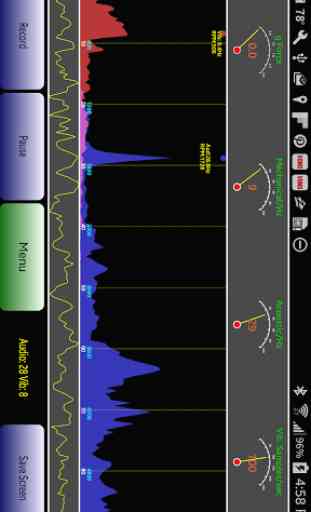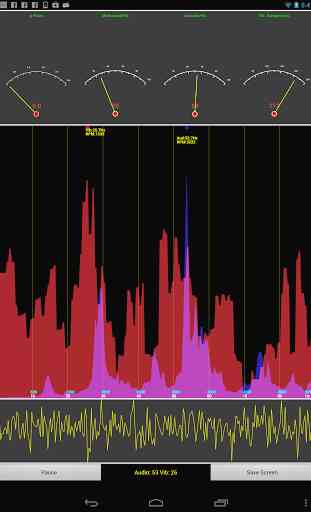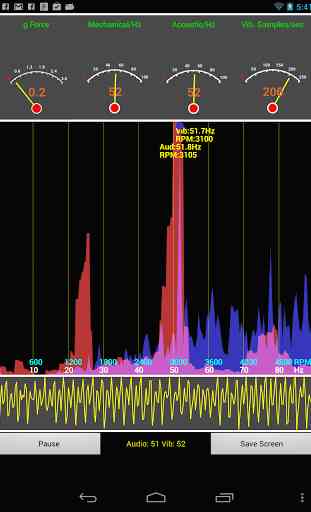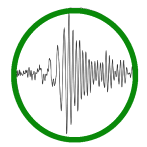Vibrations!
This is (currently) the only app that combines acoustic *and
* mechanical measurements!
Uses: monitoring vehicle engine vibration, monitoring vibrations of household appliances (dishwasher, refrigerator, waste disposal units, clothes dryers, etc.), measuring g-force in moving vehicles, helping to identify failing gears, evidenced by knocking sounds, modes, etc..
Vibrations uses data streams from the built-in accelerometer and microphone: it calculates two simultaneous FFTs, one from the mechanical measurements, one from the audible measurements. It then shows the frequency spectra on the screen. The frequency axis is labelled in Hz and RPM (revolutions per minute).
Four on-screen software gauges give an overview of the measurements:
1) The g-force (excluding gravity), which measures acceleration2) The frequency of the current peak in the mechanical/vibration noise3) The frequency of the current peak in the acoustic noise4) The sample rate at which mechanical vibrations are being measured
Screen shots can be taken using the "Save Screen" button, and stored to the SD card.
Time series of accelerometer data (up to 20 seconds) can be recorded and saved using the "Record Data" button. Since data are continually being gathered, the recorded data written to the file actually starts a second or so *before
* the button was pressed. Recording can be interrupted while in progress, and the data discarded or saved. Otherwise, the recording will automatically terminate after 20 seconds have elapsed, and the data discarded or saved then.
Data collection can be paused and resumed using the "Pause"/"Resume" button.
This is the first release of this app, and ideas for improvements/enhancements are welcome: please contact me.
Also, please note that the frequency limit of the mechanical vibration measurement is limited by the maximum rate that accelerometer samples can be obtained from the Android device: this typically varies from device to device
- e.g. on the Nexus 7 and 10 tablets, the rate is ~200 samples/sec, giving a maximum frequency measurement of ~100Hz or 6000 RPM. On the Galaxy S3 the rate is ~100 samples/sec, giving a maximum frequency of ~50Hz.
Category : Maps & Navigation

Reviews (10)
Great app, but I'd like to know how to analyse dat file to retrieve frequently data after testing?
Performs as advertised, many more options than most
Nice straight forward app. I used it to measure a road vibration suspected to be caused by an unbalanced new tire. A clear 28 Hz peak jumped right out at a speed where my tire rotates at 14 Hz. So I'm getting a second order tire induced vibration, it would seem. One problem - where are the screen shots saved? Mine are nowhere to be found?
Great appreciation, very sensitive. Highly recommended. Thanks for another very useful app.
This app works very well and is very sensitive.
Great for diagnosing vehicle vibrations
Use this app for NVH diagnosis on cars. Also works great as a single cylinder tachometer. Picks up frequencies fast and is very accurate. I do have a question, when I save an image I get a 0kb blank file that wont open, also it saves as a PNG which my phone wont pick up right, is it my phone doing this or a bug? A suggestion I have is a freeze screen button. Sometimes I can't see the screen if the frequency is too severe, if I could freeze the screen and read the Hz real quick it would be nice
Attempting to troubleshoot a drive-line vibration, saved data but can't open it on phone?
Measured frequency on a variable speed compressor very precisely. Sadly it works only in 50 Hz range on my phone. Acoustic measurements r not as precise as meachanical. But still great app! I wish there were more adjustments and options if author still works on it.





Truly love this app, but wish I could zoom in. Data is very small.